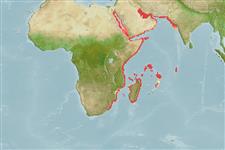Ikan bertulang rawan (sharks and rays) >
Torpediniformes (Electric rays) >
Torpedinidae (Electric rays)
Etymology: Torpedo: Latin, torpere = be sluggish (Ref. 45335).
Issue
Torpedo zugmayeri Engelhardt, 1912 could be a valid species after Weigmann (2016; Ref. 106604) (valid in ECoF, v. Jan. 2021).
Environment: milieu / climate zone / depth range / distribution range
Ekologi
laut; payau berasosiasi dengan karang; kisaran kedalaman 1 - 200 m (Ref. 9710). Tropical; 30°N - 31°S, 30°E - 72°E (Ref. 114953)
Western Indian Ocean: Persian Gulf (Ref. 80050), Red Sea eastward to India (Ref. 2712) and southward to Natal, South Africa (Ref. 5578).
Size / Weight / umur
Maturity: Lm ? range ? - ? cm
Max length : 130 cm TL jantan/; (Ref. 2712)
deskripsi pendek
Kunci identifiaksi (pengenalan) | Morfologi | Morfometrik
Large ray with a small caudal fin and with papillae around the spiracles (Ref. 5578). Bright color pattern of circles and irregular marks, cream or golden on dark red or brown to blackish background dorsally (Ref. 5578).
Found inshore in sandy bottoms, and well offshore from the surf zone down to 200 m (Ref. 5578). Also on or near coral reefs (Ref. 12951, Ref. 114953). Common in shallow sandy areas (Ref. 2712). Feeds on bony fishes (Ref. 12951) and benthic invertebrates (Ref. 114953). Ovoviviparous (Ref. 50449). Males mature by 30 cm TL (Ref. 114953). Occurs singly but may form groups during the breeding season (Ref. 12951). Occasionally hooked by anglers, more often seen by divers; can deliver a strong shock (Ref. 2712). Flesh is edible (Ref. 12484). Can survive for hours after being stranded on the beach (Ref. 41394).
Exhibit ovoviparity (aplacental viviparity), with embryos feeding initially on yolk, then receiving additional nourishment from the mother by indirect absorption of uterine fluid enriched with mucus, fat or protein through specialised structures (Ref. 50449). With 9-22 in a litter (Ref. 12951). Form aggregations during the reproductive season (Ref. 41394).
Compagno, L.J.V., 1986. Torpedinidae. p. 112-113. In M.M. Smith and P.C. Heemstra (eds.) Smiths' sea fishes. Springer-Verlag, Berlin. (Ref. 2712)
Status IUCN Red List (Ref. 130435)
penggunaan manusia
Ikan buruan: ya
Alat, peralatan
laporan khas
muat turun XML
Sumber internet
Estimates based on models
Preferred temperature (Ref.
123201): 21.8 - 28.3, mean 25.5 °C (based on 370 cells).
Phylogenetic diversity index (Ref.
82804): PD
50 = 0.5005 [Uniqueness, from 0.5 = low to 2.0 = high].
Bayesian length-weight: a=0.01585 (0.00973 - 0.02580), b=3.00 (2.86 - 3.14), in cm total length, based on LWR estimates for this species & (Sub)family-body (Ref.
93245).
Trophic level (Ref.
69278): 4.5 ±0.80 se; based on food items.
Daya lenting (Ref.
120179): sangat rendah, Waktu penggandaan populasi minimum lebih dari 14 tahun (Fec=9-22).
Fishing Vulnerability (Ref.
59153): Very high vulnerability (78 of 100).
